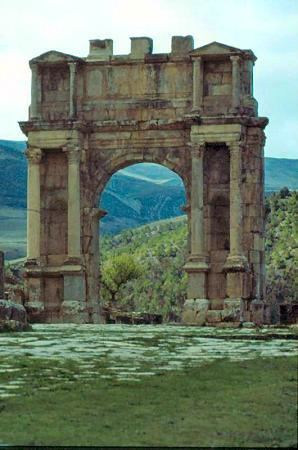Alternate name Cuicul Founded 1st century AD | Type Settlement Abandoned 6th century AD Local time Thursday 4:30 AM | |
 | ||
Weather 5°C, Wind NW at 8 km/h, 88% Humidity | ||
Djémila (Kabyle: Ğamila; Arabic: جميلة, the Beautiful one, Latin: Cuicul or Curculum), formerly Cuicul, is a small mountain village in Algeria, near the northern coast east of Algiers, where some of the best preserved Berbero-Roman ruins in North Africa are found. It is situated in the region bordering the Constantinois and Petite Kabylie (Basse Kabylie).
Contents
Map of Djemila, Algeria
In 1982, Djémila became a UNESCO World Heritage Site for its unique adaptation of Roman architecture to a mountain environment. Significant buildings in ancient Cuicul include a theatre, two fora, temples, basilicas, arches, streets, and houses. The exceptionally well preserved ruins surround the forum of the Harsh, a large paved square with an entry marked by a majestic arch.
Roman Cuicul
Under the name of Cuicul, the city was built at 900 meters of altitude during the 1st century AD as a Roman military garrison situated on a narrow triangular plateau in the province of Numidia. The terrain is somewhat rugged, being located at the confluence of two rivers.
Cuicul's builders followed a standard plan with a forum at the center and two main streets, the Cardo Maximus and the Decumanus Maximus, composing the major axes. The city was initially populated by a colony of Roman soldiers from Italy, and eventually grew to become a large trading market. The resources that contributed to the prosperity of the city were essentially agricultural (cereals, olive trees and farm).
During the reign of Caracalla in tkhe 3rd century, Cuicul's administrators took down some of the old ramparts and constructed a new forum. They surrounded it with larger and more impressive edifices than those that bordered the old forum. The terrain hindered building, so that they built the theatre outside the town walls, which was exceptional.
Christianity became very popular in the 4th century (after some persecutions in the early third century) and brought the addition of a basilica and baptistry. They are to the south of Cuicul in a quarter called "Christian", and are popular attractions.
Of the bishops of Cuicul, Pudentianus took part in the 256 Council of Carthage concerning the validity of heretical baptism, and Elpidophorus in that of 348. Cresconius was the Catholic bishop who represented Cuicul at the 411 Conference of Carthage between Catholic and Donatist bishops; the Donatist bishop of the town died before the conference began. Crescens was one of the Catholic bishops whom the Arian Vandal king Huneric summoned to Carthage in 484. Victor was at the Second Council of Constantinople in 553. No longer a residential bishopric, Cuicul is today listed by the Catholic Church as a titular see.
The city was slowly abandoned after the fall of the Roman Empire around the 5th century and 6th century. There was some improvements under emperor Justinianus I, with Wall reinforcements.
Muslims later dominated the region, but did not reoccupy the site of Cuicul, which they renamed Djémila ("beautiful" in Arabic).
Famous residents
Several significant Romanized Africans were born in Cuicul:
